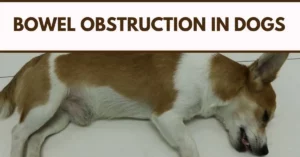Your cart is currently empty!
Reviewed by: Dr. Peter Doherty
Intestinal blockage in dogs—also known as gastrointestinal obstruction—can quickly turn into a life-threatening emergency. As a dog owner in the U.S., recognizing the early signs of intestinal blockage in dogs could save your pet’s life.
According to the American Kennel Club (AKC) and board-certified veterinary surgeons, foreign objects account for up to 80% of canine bowel obstructions, with common culprits including toys, socks, bones, and corn cobs.This comprehensive guide breaks down the red-flag symptoms, risk factors, diagnostic steps, and treatment options


An intestinal blockage occurs when something physically prevents food, fluid, or gas from moving through the digestive tract. Blockages can be:
Veterinary Stat: The Journal of the American Veterinary Medical Association (JAVMA) reports a 90% survival rate when surgery is performed within 24 hours of complete obstruction.
Vomiting is the #1 symptom. Look for:
Pro Tip: Film the episode—vets use timing and content to assess urgency.
Dogs with blockages become unusually quiet or collapse. Pain causes a “hunched” posture with a tense abdomen.
Even normally food-obsessed dogs refuse treats. This starts 6–12 hours after the blockage.
Pinch the skin on your dog’s neck—if it stays “tented,” dehydration is severe. Gums become dry and tacky.
Dogs strain to vomit but nothing comes up (similar to bloat/GDV).
Excess saliva and foul odor signal nausea and toxin buildup.
Pacing, restlessness, or hiding—classic pain responses.
| Risk Factor | Examples | Breeds Prone |
|---|---|---|
| Toy ingestion | Socks, tennis balls, kids’ toys | Labradors, Pit Bulls, Goldens |
| Bone fragments | Cooked chicken bones, rib bones | Small breeds (Yorkies, Chihuahuas) |
| Linear objects | Dental floss, yarn, holiday tinsel | Cats and curious puppies |
| Mass/tumor | Intestinal cancer (rare in young dogs) | Boxers, German Shepherds (seniors) |
2025 Update: The FDA’s Center for Veterinary Medicine warns that rawhide chews caused 12% of obstructions in a recent multi-state study.
Go to the ER immediately if your dog shows 2+ of these within 12 hours:
Average U.S. Cost: Emergency surgery ranges from $3,000–$7,000 (PetMD 2025 data). Pet insurance often covers 70–90%.
| Method | Best For | Success Rate |
|---|---|---|
| Endoscopy | Objects in stomach/duodenum | 60–70% |
| Exploratory Surgery | Small intestine or complete blockages | 85–95% |
Post-op: IV fluids, pain meds, and a strict bland diet (Hill’s i/d or Royal Canin GI) for 7–14 days.
Signs of intestinal blockage in dogs escalate fast. If your pup shows repeated vomiting, no stool, or a painful belly, don’t wait—call your vet or the nearest 24/7 animal ER. Early intervention is the difference between a $500 endoscopy and a $7,000 surgery.